CHART Art Fair, 28 - 31 August,
presented by Lagune Ouest alongside works by Asta Lynge and Henrik Plenge.
Portrait as Landscape / Doppelganger 2025 200x130cm, oil on canvas
CHART Art Fair, 28 - 31 August,
presented by Lagune Ouest alongside works by Asta Lynge and Henrik Plenge.


Portrait as Landscape / Doppelganger 2025 200x130cm, oil on canvas




dirt
31.01.2025 - 01.03.2025
a group exhibition with works by Astrid Svanberg, Laurence Sturla and Moa Alskog at Lagune Ouest




FORTRYLLET ER ØJET / ENCHANTED IS THE EYE, LAGUNE OUEST, 02.06.23 - 01.07.2023

Press release, Maj 2023
The exhibition “Fortryllet er øjet” by artist Moa Alskog consists of new paintings, drawings and embroidery. Works that deal with cabbage, the cabbage moth, painting, the experience of the world and the production of meaning. The enchanted eye.
Vildtvoksende kål er en hårdfør plante med seje, sennepsbitre blade og små gule blomster. Den trives på strande og kalkholdige klipper ved havet. Gennem årtusinder er planten blevet avlet på, ligesom ulven, til ukendelighed. Fra stænglerne stammer kålrabi, fra bladene grønkål, palmekål, purpurkål, fra bladknopperne rosenkål, hvidkål, rødkål, spidskål, savoykål, fra blomsterknopperne blomkål, romanesco, broccoli, fra frøene sennep, raps. Alle dele af den vilde kålplante – og alle de afgrøder, der nedstammer fra den – indeholder glukosinolater, plantens eget værn mod insekter. De smager grimt for nogle smagsløg, mens andre munde mæsker sig i dem.
Kåluglen er en natsværmer, der gemmer sig i kålen om dagen og lægger æg på bladenes undersider. Larverne gnaver vinduer i kålens labyrinter, så kålen som afgrøde må sprøjtes eller tildækkes. Kåluglens fødereservoir er de sidste to tusind år udvidet fra en begrænset population af nøjsomme planter ved Middelhavets kyst til deformt svulmende plantedele sat i velgødet jord overalt på planeten. Det er sandsynligt, at mennesker, ved at avle på kålen, utilsigtet har avlet på kåluglen. Når larverne har spist, hvad de kan, forpupper de sig i jorden og danner et sæt spættede vinger. I det spættede gemmer sig billeder. Synlige, måske, for kålugleøjne.
Amalie Smith, Foråret 2023

Meta (to change) morphosis (form), at night under the influence of unsettling dreams or wrapped up in a cocoon (detail).




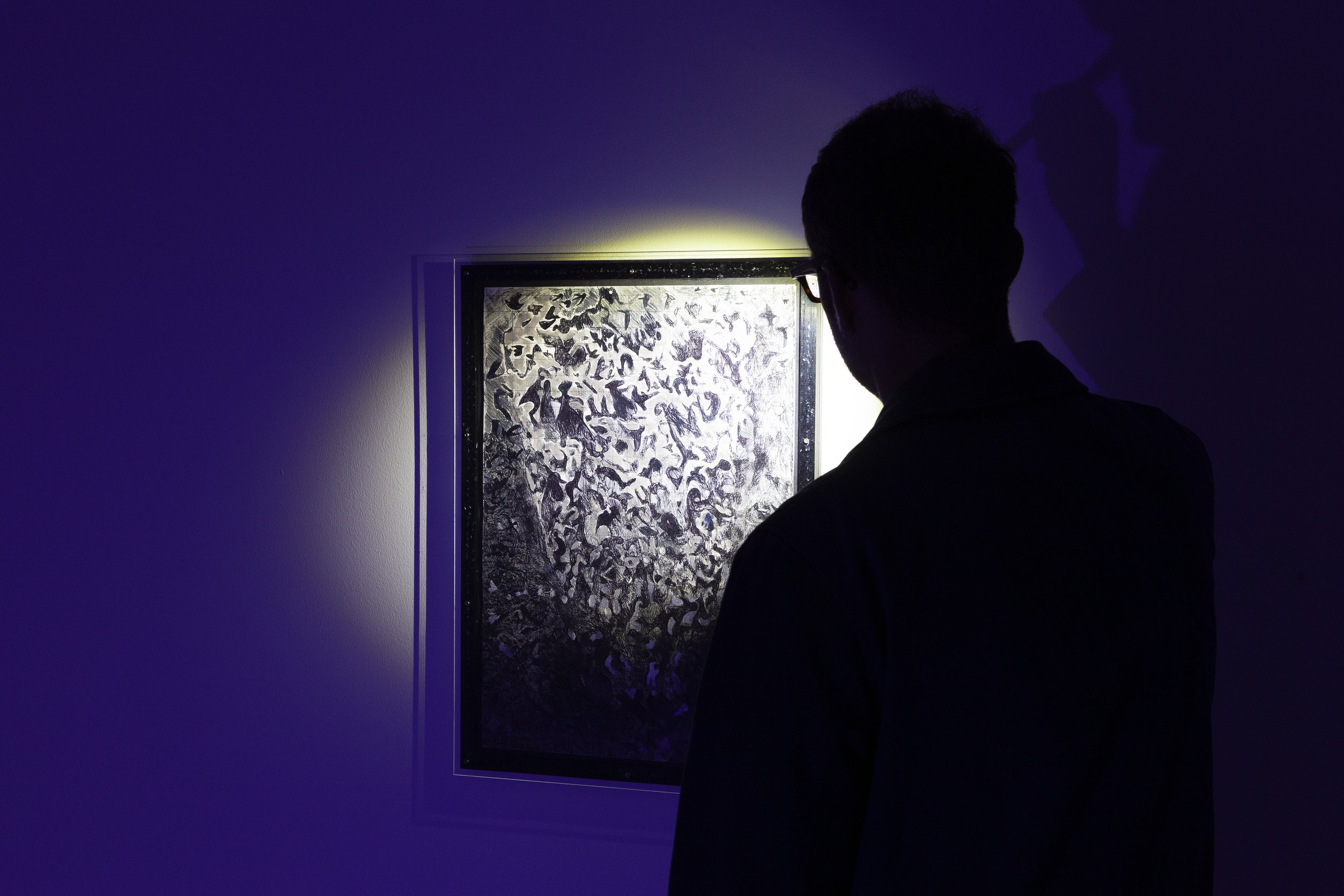
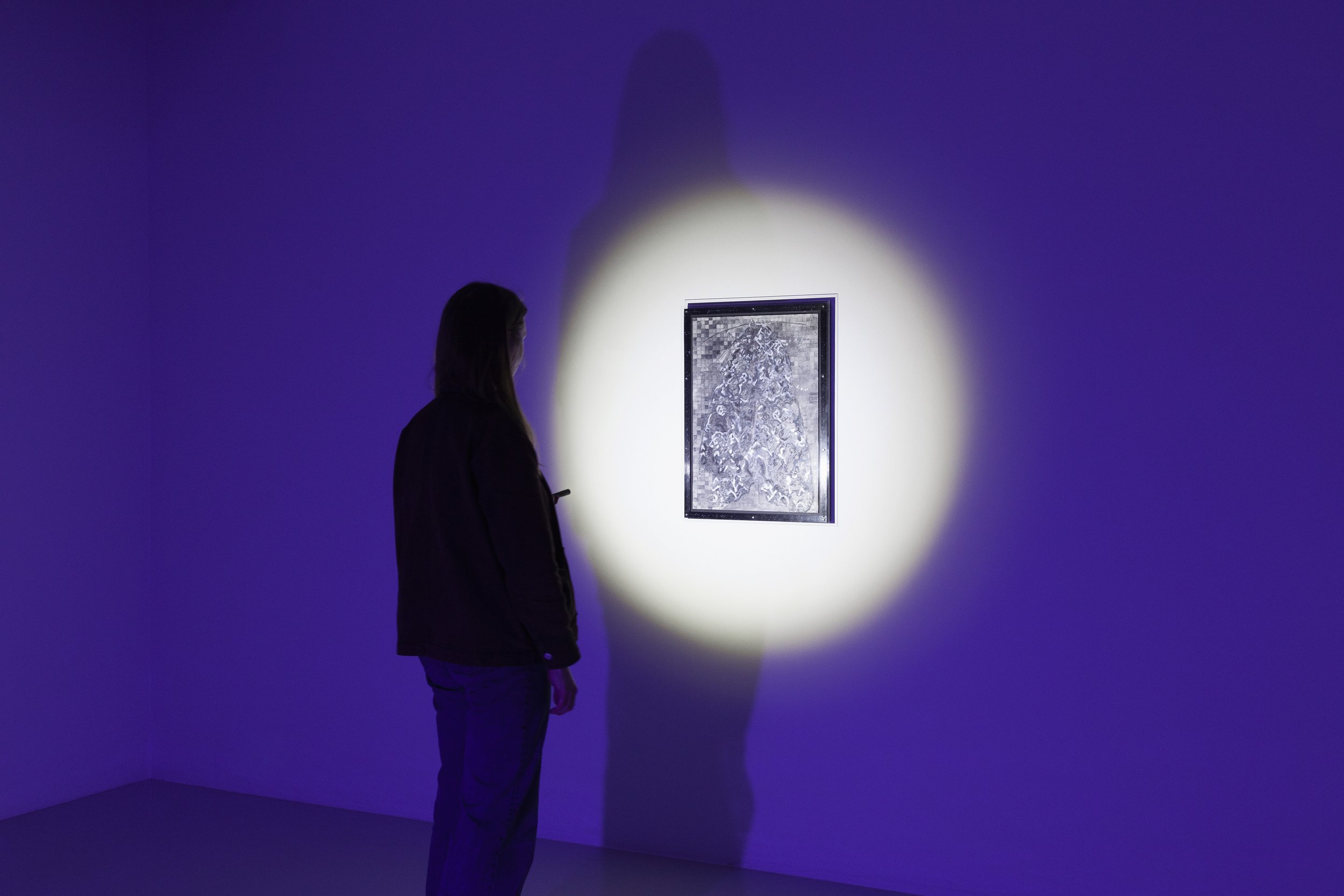







Pieris Brassicae (Life is Life). 2022-23. Oil on dibond. Frame: recycled plastic material, 76,5 x 70,5 x 4,5 cm. Photo: Courtesy of the artist & Lagune Ouest.


Kajorna. 2023. Oil paint, ball pen and marker on paper. Frame made of MDF, recycled plastic material and plexiglas. 66,5 x 49 x 3,7 cm. Photo: Courtesy of the artist & Lagune Ouest.
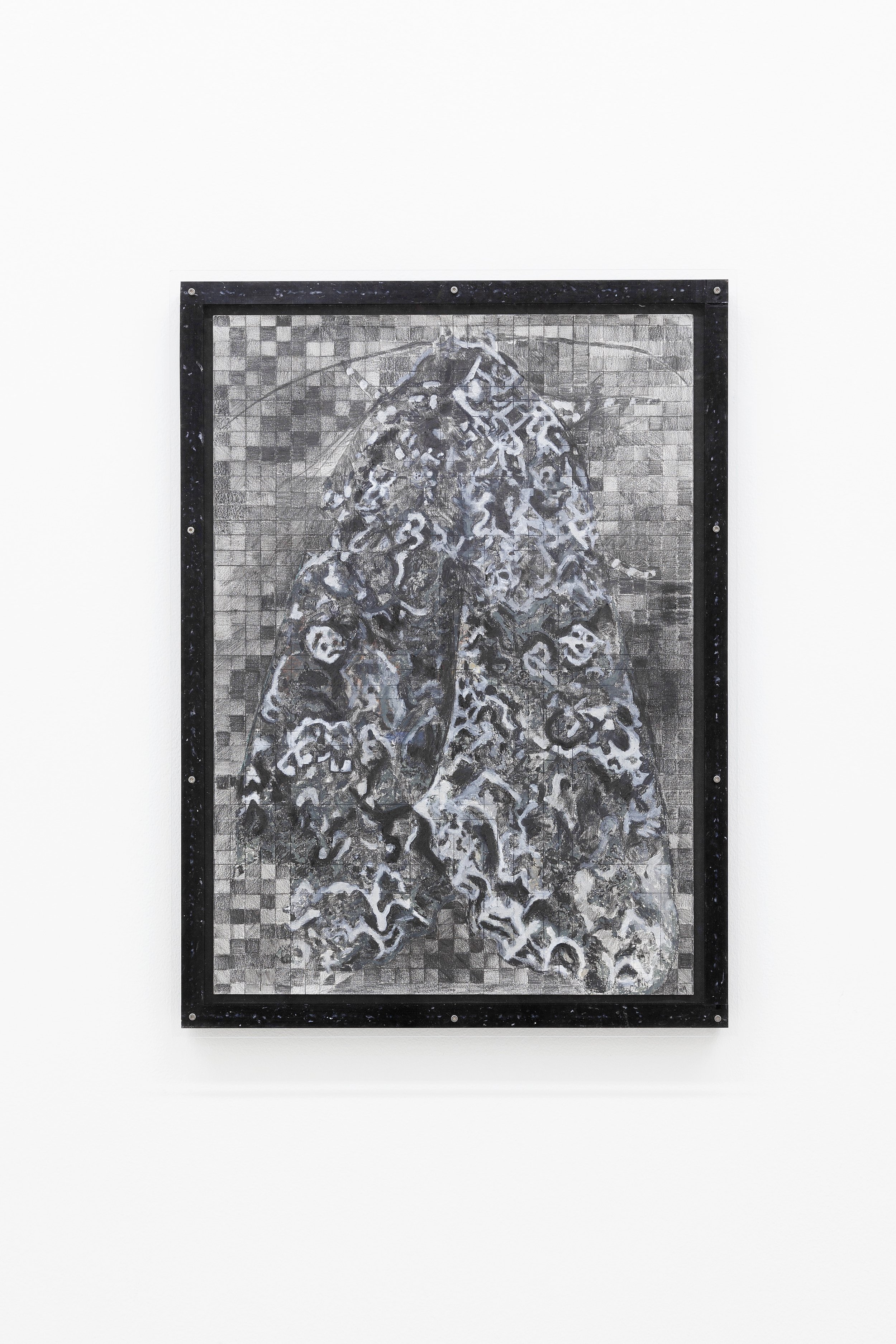
Så kallad kålfly. 2022-23. Pencil, dry pastel and oil pastel and on paper. Frame made of MDF, recycled plastic material and plexiglas. 66,5 x 49 x 3,7 cm. Photo: Courtesy of the artist & Lagune Ouest.
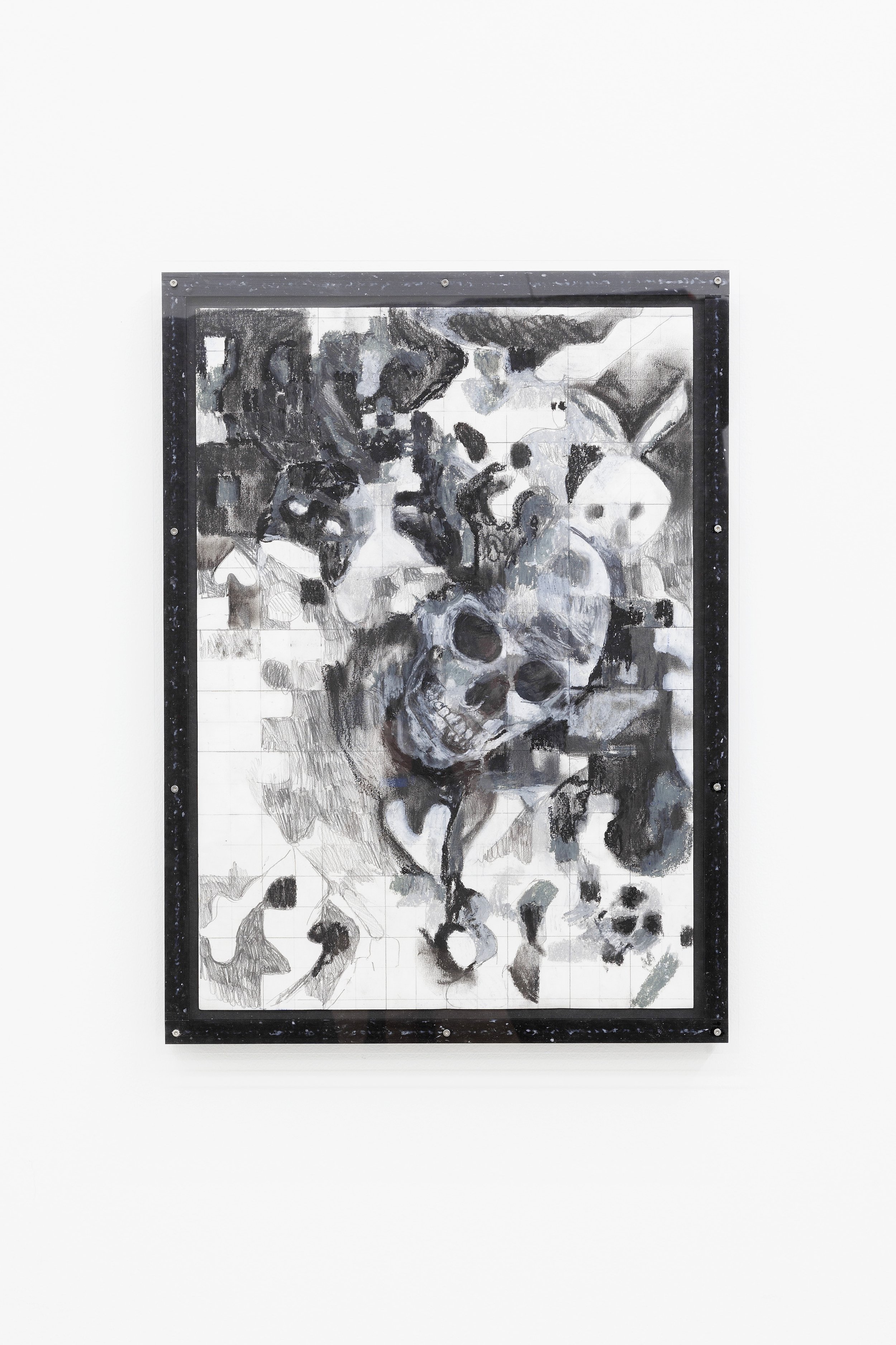
Untitled. 2023. Pencil, dry pastel and oil pastel and on paper. Frame made of MDF, recycled plastic material and plexiglas. 66,5 x 49 x 3,7 cm. Photo: Courtesy of the artist & Lagune Ouest.

Labyrinth no. 3. 2023. Aluminium foil, acrylic, sequins and beads on insect net. 48 x 38 x 2 cm. Photo: Courtesy of the artist & Lagune Ouest.
MARKET ART FAIR, 12-14 maj, 2023

Booth S6, Market Art Fair, Duo-presentation alongside Emilie Bausager, with Lagune Ouest
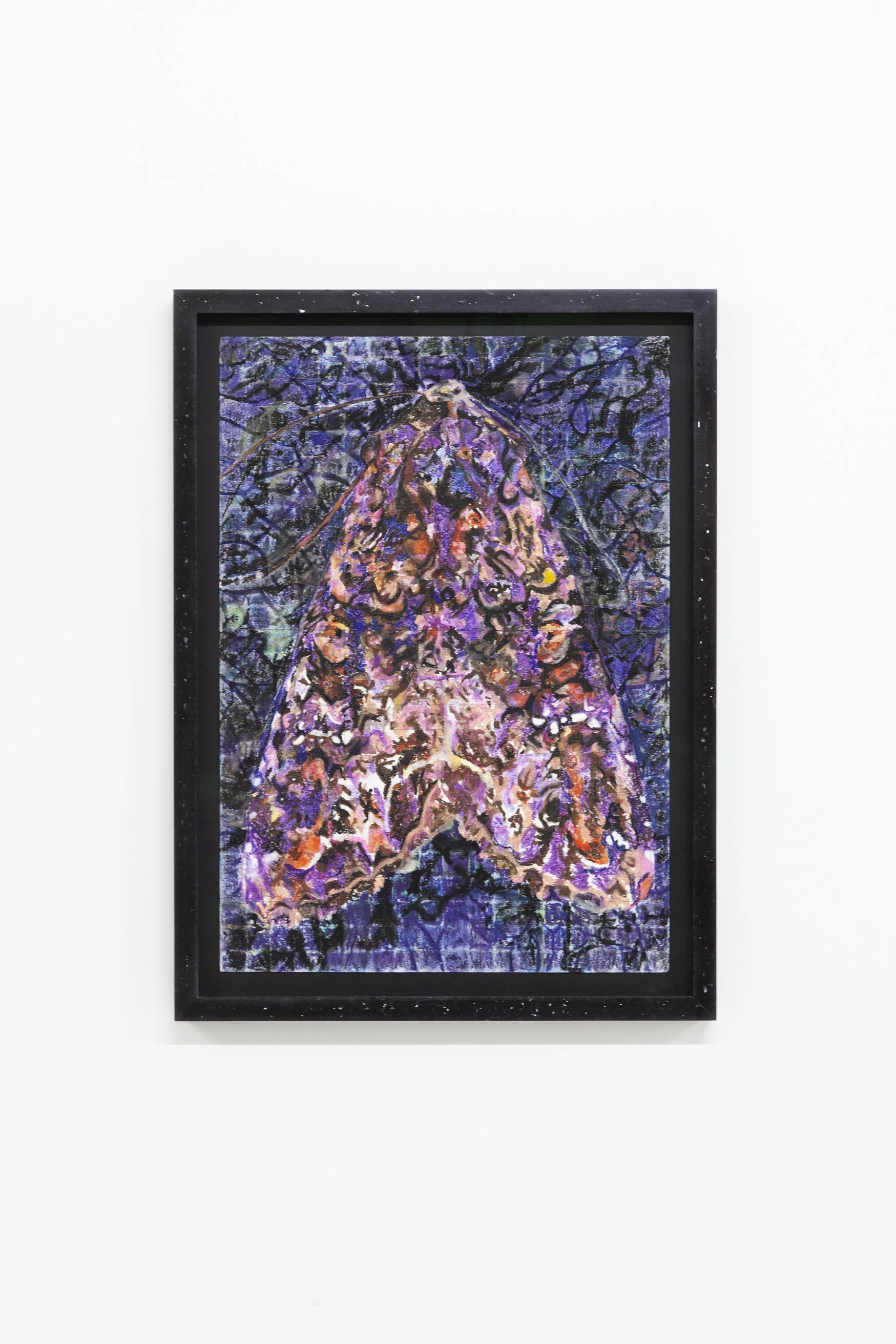
Kålfly, Kålugle, Cabbage moth, dry pastel, oil pastel, couloured pencil, pencil on paper, recycled plastic material, 76.5x 50 x4.5cm, 2023

Jesus! ,dry pastel, oil pastel, couloured pencil, pencil on paper, recycled plastic material, 76.5x 50 x4.5cm, 2023

Booth S6, Spritmuseum, duo-presentation alongside Emilie Bausager, with Lagune Ouest

Pieris Brassicae (hjärtat till vänster, lysande ansikte), oil on dibond, recycled plastic material, 115x115 cm, 2023

Booth S6, Market Art Fair, Duo-presentation alongside Emilie Bausager, with Lagune Ouest

Nigredo, ,dry pastel, oil pastel, couloured pencil, pencil on paper, recycled plastic material, 76.5x 50 x4.5cm, 2023
PIERIS BRASSICAE (LIV(F)E IS LIFE)
BAKA D’BUSK 20.03.22 - 16.05.22
2022, oil on Dibond, 74x68 cm
Documentation Malle Madsen
2022, oil on Dibond, 74x68 cm
Documentation Malle Madsen
2022, oil on Dibond, 74x68 cm
Documentation Malle Madsen
2022, oil on Dibond, 74x68 cm
Documentation Malle Madsen
DELUGE MOA ALSKOG & JAVIER TAPIA at LAGUNE OUEST 210122 - 120222


My Loneliness is Killing Me, I Must Confess I Still Believe, 150x110cm, oil on Dibond, 2022
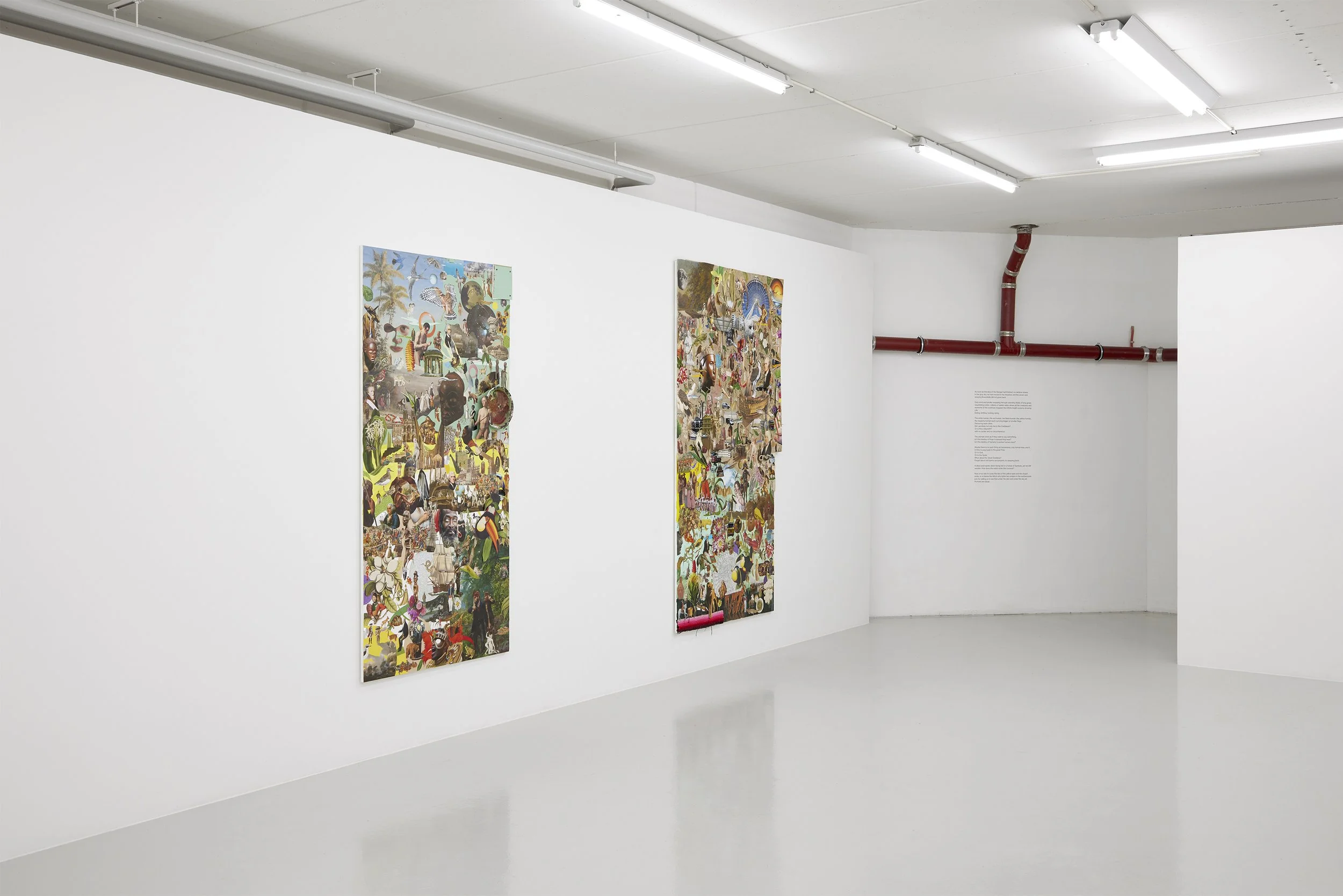

2021, 150x110cm, oil on Dibond
Photo credit: Malle Madsen
2021, 150x110cm, oil on Dibond
2021, 150x110cm, oil on Dibond
HAVEBIENNALEN 280821- 150921

They say that Leda once found an egg - like a hyacint 2021 Oil on Dibond 41,7 x 33 cm

The Earth is Littered with the Ruins of Empires that Believed They Were Eternal 2021 Oil on Dibond 41,7 x 33 cm
WET WITH DEW, Publication, 2020
Cecilie Skov & Moa Alskog with text by Eleanor Ivory Weber, Edited and produced by Eller med a Δ Åbäke, printed by Grafiche Veneziane,
Published by Forlaget emancipa(t/ss)ionsfrugten. 2020

VÅT AV DAGG / WET WITH DEW
Moa Alskog och Cecilie Skov
5/4 – 22/4 2019 @DELFI, Malmö, SE
Med stöd av Statens Kunstfond och Malmö Stad Kulturstöd.


Under månens sken (Under the light of the moon), färgpenna på papper, 29,7x21 cm, Moa Alskog


PRESSTEXT - VÅT AV DAGG
Är människans herravälde över jorden Guds fel, som på den sjätte dagen efter att ha skapat himmel och jord skapade människan, välsignade henne och sa ’Var fruktsamma och föröka er, uppfyll jorden och lägg den under er. Härska över havets fiskar och himlens fåglar och över alla djur som myllrar på jorden’? Eller beror vår komplicerade relation till andra arter på Descartes som skilde kroppen från själen? En idé som beredde väg för föreställningen om ’naturen’ som död och jorden som en resurs för människan att exploatera, på samma sätt som den ’jordbundna’ kvinnan för mannen. Eller är det bara för att vi inte har någon självinsikt som vi fortsätter att ’slösa och uttömma den sista energin, bara för att producera högar och högar av saker, fula saker, värdelösa saker och i bästa fall helt onödiga saker’ som Voltairine de Cleyre uttryckte det i sin essä ’The dominant idea’ från 1910? Är det också anledningen till att vi idag inte kan se utanför rummet och dyrkar naturvetenskapen så till den grad att vi förträngt annat: det vi inte ser, inte kan mäta eller väga som till exempel det minsta och det största, döden, medvetandet, oändligheten och omsorgen?
Varje dag är en undergång för flera fisk-, fågel-, växt- och insektsarter. De liknar oss mer än vi tror, inte bara människor känner smärta, är medvetna, gillar sex, kommunicerar. Vi hänger ihop som vattnet som cirkulerar genom våra kroppar. Behållaren var den första uppfinningen, inte vapnet, enligt Ursula Le Guin. Olika ljus får olika saker att träda fram, sa Jonna Bornemark, och Judith Butler konstaterar att könet skapas genom upprepade handlingar och att genuslek ’kan ge upphov synnerligen sammansatta luststrukturer’. Tänk cirkulärt, repetitivt, spirallikt, inte trädlikt progressivt.
Cecilie Skov och Moa Alskog kuraterade år 2014 en serie om fem utställningar med fokus på nymaterialism med titeln ’Sig mig at tingene taler’. Sedan dess har de fört ett kontinuerligt samtal om konst, litteratur, feminism och ekologi. I utställningen ’Våt av dagg’ visar Cecilie skulpturer som tar sin utgångspunkt i kroppen av vatten, behållaren och vattenpölen som ett stadie av vatten i cirkulation. Moa visar tecknin-gar inspirerade av grodans symboliska transformation – från att symbolisera fertilitet, liv och metamorfos i gamla Egypten blev grodan djävulens hantlangare och en symbol för kvinnlig lössläppthet i medeltidens Europa.
Text av Moa Alskog
——————————————————————————————————
PRESS TEXT - WET WITH DEW
Is the human dominion of the earth the fault of God, who on the sixth day after creating heaven and earth created the human, blessed her and said: ‘Be fruitful, and multiply, and replenish the earth, and subdue it: and have dominion over the fish of the sea, and over the fowl of the air, and over every living thing that moveth upon the earth’? Or is our complicated relation with other species the fault of Descartes who separated the body from the mind, an idea that prepared the way of the view of ‘nature’ as dead and earth as a resource for the human to exploit, in the same way as the “earthbound woman” for the man. Or is it just because we do not have any selfawareness of the fact that we continue the ‘…wasting and draining of the last bit of energy, only to produce heaps and heaps of things, —things ugly, things harmful, things useless, and at the best largely unnecessary’ as Voltairine de Cleyre wrote in her 1910 essay ‘The dominant idea’? Is that also the reason why we cannot see outside the room and worship the natural sciences to such a degree that makes us repress other things: things we cannot see, measure or weigh such as the smallest and the biggest, death, consciousness, eternity and caretaking?
Every day is a doomsday for several species of fish, birds, plants or insects. They are more complex than we think; it is not only humans who feel pain, are conscious, enjoy sex, communicate. We are connected like the water that circulates through our bodies. The container was the first cultural invention, not the sword according to Ursula le Guin. Different lights make different things appear, said Jonna Bornemark and Judith Butler stated that repeated acts makes the sex, and gender play ‘can constitute highly complex and structured production of desire’. Think circular, repetitive, spirallike, not treelike progressive.
Cecilie Skov and Moa Alskog curated a series of five exhibitions with a focus on new Materialism, entitled ‘Sig mig at tingene taler’ in 2014. They have engaged in a continuous conversation about art, literature, feminism and ecology since then. In the exhibition ‘Wet as dew’, Cecilie presents sculptures inspired by the container, the body of water and the puddle as a stage of water in circulation. For her part, Moa is exhibiting drawings she made inspired by the frogs’ symbolic metamorphoses – from symbolizing fertility, birth and life in ancient Egypt to the frog becoming the devil’s henchman and a symbol of female promiscuity in the Middle Ages.
Text by Moa Alskog
—————————————————————————————————————————————————————————————————————
EARLY SPRING
Kah Bee Chow och Moa Alskog
5/4 - 23/4 2019 @ORGANON, Odense DK
Supported by Statens Kunstfond.


I väntan på doktorn / Waiting for the doctor (2019) färgpenna på papper, 29,7x21cm, Moa Alskog

Kronans skugga / The shadow of the crown (2019) färgpenna på papper 29,7x21cm, Moa Alskog


Gravid Maja / Pregnant Maja (2019), färgpenna på papper, 29,7x21cm, Moa Alskog
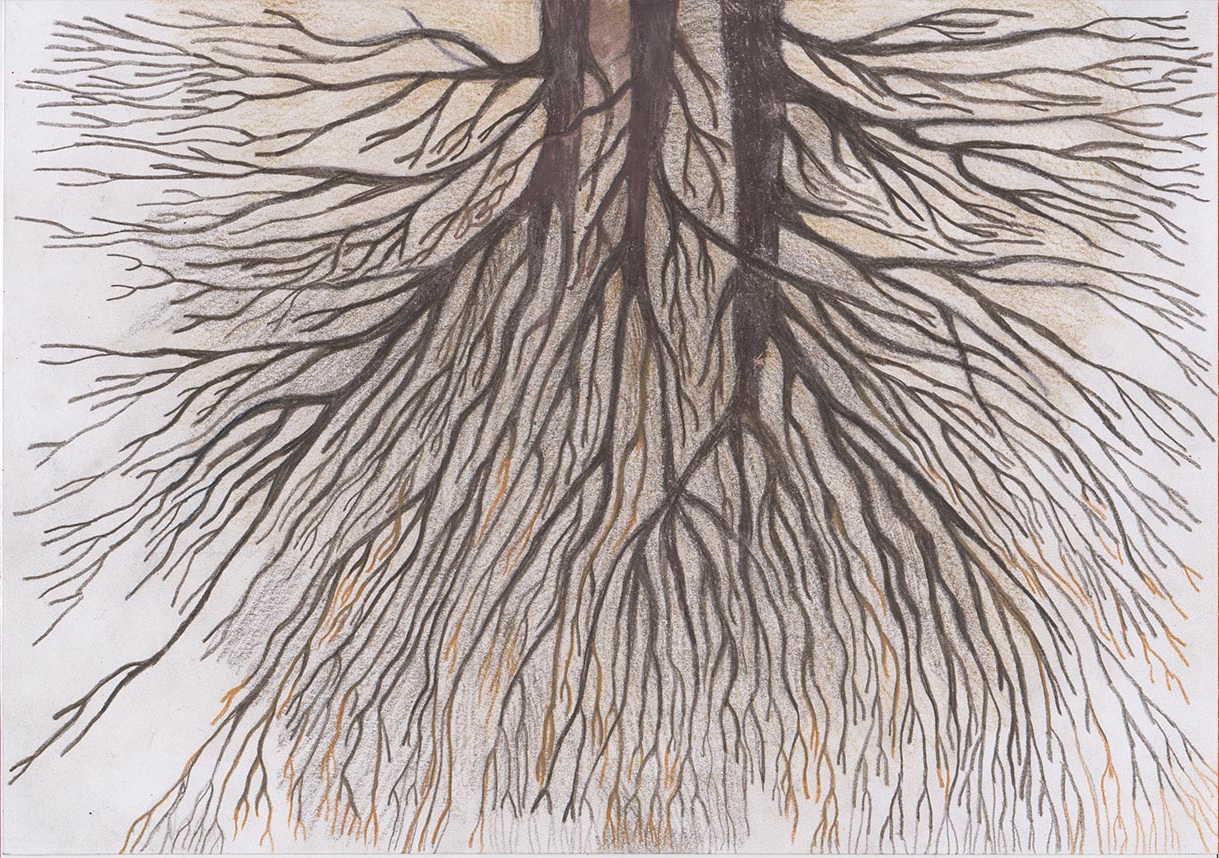
Underjord / Underground (2019), färgpenna på papper, 29,7x21 cm, Moa Alskog

Svart sol / Black sun, (2019), färgpenna på papper, 29,7x21, Moa Alskog

PRESS:
Moa Alskog and Kah Bee Chow meet over a shared interest in trees, leaves, reptiles, amphibians and the human gaze in the duo exhibition Early Spring.
Moa Alskog will present a series of drawings that takes its starting point in the frog’s symbolic transformation – from being connected to life, fertility and birth in ancient Egypt, the frog became the devil’s henchman in the middle ages. The project is part of a long-term investigation into primarily western mythologies and history, through which she tries to get a better understanding of how the modern human’s relation to ‘nature’ has been shaped.
Moa Alskog graduated from the Royal Danish Academy of Fine Arts in 2016. She uses text, drawing, textile and video to make stories that investigates relations, language and the gaze.
Kah Bee Chow will present prints and experiments developed in a makeshift darkroom she built during her stay in Marseille in the fall of 2018. They came from a desire to work responsively to the environment and temperament of the city; incorporating plants, discarded rubbish and found material from her daily walks.
Kah Bee Chow is based in Malmö Sweden. She usually works with forms of enclosures in relation to animals and the human body, with close attention to particularities of space and site. Her work with sculpture, video and text often links disparate events and references as generative threads, imagining narratives and taxonomies through movement and flows, etymologies and architecture.
http://www.kahbeechow.com/
Blåklocka Blåklocka / Bluebell Bluebell
Moa Alskog och Harry Anderson
27.04.18 – 19.05.18 @Danske Grafikernes Hus, Köpenhamn, Dk http://danskegrafikere.org/
Med stöd av Statens Kunstfond och Grosser LFoghts Fond


The Third Stage of Death (2017), watercolor on wood, Harry Anderson.

Bliss (2018), flouresent lights, inkjet prints, Moa Alskog



Ve den, för vars skull ängen suckar och humlan gråta! (2018), film 10:00 min, Moa Alskog

Bringin' It All Back Home (2018), painted ceramics, Harry Anderson

PRESSTEXT:
Marknadsvärdet representerar vad någon är villig att betala för en produkt – inte det värde som är den är prissatt till eller egentligen värd enligt finans-ordboken www.investinganswers.com. Funktionen är sekundär och priset speglar konsumentens känslor inför den, snarare än de resurser och den arbetskraft som krävts för att producera den. De flesta produkter är heller inte gjorda för att uppfylla basala behov, utan för att bygga individers identiteter. De är tecken som berättar historier om oss. Historier vi lärt oss läsa och förstå bättre än vi förstår hur och var sakerna kommer ifrån. Det eftersom produktionen ofta sker genom komplexa industriella processer, i stora kvantiteter, utanför städerna. Städer där majoriteten av mänskligheten bor, där butikerna finns, där hyllorna fylls och töms. Städer av asfalt och betong, där man kommunicerar genom medier, fyllda av bilder som representerar en verklighet. En verklighet verkligare än verkligheten själv, som Baudrillard skulle uttryckt det, där fisken är en pinne och kon är nöt.
I den verkligheten kan man gå vilse och glömma att producenter producerar varor inte bara för att fylla behov men för att skapa flera. Att det är mer ekonomiskt för en butik att slänga överflödiga äpplen än att sänka priset på dem; att jordbrukare odlar mer än vad de kan sälja och låter delar av grödan ruttna på fältet för att garanterat kunna möta efterfrågan från butikerna; att butikschefer beställer hem fler varor än de behöver eftersom halvfulla hyllor anses oattraktiva; att konsumenterna missförstått ’bäst före datumet’ och tror att det är en absolut gräns, trots att den anger perioden då varorna är som allra bäst. En ”effektiv” verklighet med en marknad av överflöd som håller livsmedelspriserna låga. Där en tredjedel av all mat som produceras globalt till människor slängs bort varje år. Där den odlade marken breder ut sig på bekostnad av andra arters liv som till exempel de vilda blommornas, där var femte art i Sverige idag anses hotad.
Blommor som förr, när en plats blivit otjänligt kunde flytta, men som inte har den möjligheten när platserna att fly befolkats. ’Refugierna har utplånats’ som professor Donna Harraway sa på en föreläsning på Evergreen State College år 2016. Och sen: allt hänger ihop, vi är alla lavar! Det som Selma Lagerlöf uttryckte med andra ord, 1891, i Gösta Berlings saga: Jag ville, att den gröna jorden inte kände mina steg som en tung börda. Jag ville, att hon gärna förläte, att hon för min skull såras med plog och harv (…) Ty det synes mig ofta, som om de döda tingen skulle känna och leva med de levande. Inte är skrankan mellan dem och oss så stor, som människor tro. Vilken del av jordens stoft är det, som inte varit inne i livets kretsgång?
Harry Anderson (f.1986, Stockholm) arbetar med teckning, måleri och skulptur. Han studerar sitt femte år på Det Kongelige Danske Kunstakademi. Han är aktuell med serieromanerna Livet är inte alltid Hawaii från 2017 och uppföljaren Det förlorade paradiset, som kommer senare i år på Kartago förlag.
Moa Alskog (f. 1985, Umeå) arbetar med text, video og installation. Hon tog sig MFA från Det Kongelige Danske Kunstakademi i København og Michaelis School of Arts Cape Town år 2016. Senaste utställningarna inkluderar Vibrant Matter på SAK i Svendborg och Jeg kler mig, ergo er jeg? på Akershus Kunsthal, Oslo.
Utställningen stöds av Grosser L Foghts Fond och Statens Kunstfond
—————————————————————————————————————————————————————
Bluebell Bluebell. an exhibition by Moa Alskog in collaboration with Harry Anderson
27.04.18 – 19.05.18 Opening 27.04. kl 17.00-20.00
Danske Grafikernes Hus Sölvgade 14, 1307 Kbh K http://danskegrafikere.org/
Market value represents what someone is willing to pay for an asset - not the value it is offered for or intrinsically worth states the financial dictionary www.investinganswers.com. The product function is secondary. The price mirrors how the consumer feels about it, rather than the resources and the physical work it has taken to produce it. Nor are most products made to fulfil basic needs, but to build the identities of individuals. They are signs that tells us stories. Histories we have learnt to read and understand, often better than we understand how and where they have come to be. Since they often are made through complex industrial processes, in big quantities, outside the cities. Cities in which the majority of people live, where the stores are located and shelves are filled and emptied. Cities made of concrete and asphalt, where most communication goes through media, brimming with images representing a reality. A reality more real than reality itself, as Baudrillard would have put it, where a fish is a stick and a cow is beef. In that reality you can get lost and forget that producers manufacture products not only to fill needs but to create more. That it is more economical for a store to discard superfluous apples than to lower their price; that farmers grow more than they can sell, and would rather let part of the crop rot on the field to guarantee in-store demands; that store managers order more goods than they can sell, to avoid “unattractive” half full shelves; that consumers have misunderstood what the expiry date means and assume it to be an absolute limit, even though it indicates the period when the food is at its best. It is an “efficient” reality, with a abundance of produce that keep food prices low. Where a third of all food produced for humans globally is wasted. Where cultivated land is spreading on the expense of other species lives, for example the wild flowers, where every fifth species is considered threatened in Sweden today. Flowers that once, when a place had become unfit for survival could move on, but whom today have fewer places to choose from as most places are already populated. The refugia have been wiped out as Donna Haraway said at a lecture at The Evergreen State College in 2016. And then: everything is connected, we are all lichens! In other words, as Selma Lagerlöf wrote, 1891, in Gösta Berlings Saga: I would like the green earth not to feel my steps as a heavy burden. I wish that she would gladly forgive that for my sake she was wounded with plow and harrow. (…) For it often seems to me as if dead things feel and suffer with the living. The barrier between them and us is not as great as people think. What part of earth’s matter is there that has not been part of the cycle of life?
Harry Anderson (b.1986, Stockholm) works with drawing, painting and sculpture. He studies his fifth year at the Royal Danish Academy of Fine arts. Last year he debuted with the graphic novel Livet är inte alltid Hawaii and in may he will publish the follow-up Det förlorade paradiset at the publishing house Kartago.
Moa Alskog (b. 1985, Umeå) works with text, video and installation. She graduated from the Royal Danish Academy in 2016. Her latest exhibition includes Vibrant Matter at SAK in Svendborg and Jeg kler mig, ergo er jeg? at Akershus Kunsthal, Oslo.
The exhibition is kindly supported by Grosser L Foghts and Fond Statens Kunstfond
Jeg kler meg, ergo jeg er. (grupputställning)
Karl Isakson och Moa Alskog
2018
@Akershus kunsthal, Oslo, NO


From Akershus Kunstsenter. Documentation: Istvan Virag. Supported by Statens Kunstfond.
Se, sedd. Ögon på en gyllene tallrik - en totalinstallation av Moa Alskog, med verk av Karl Isakson, Viktoria Wendel Skousen, Sara Ursina, Ingrid Eggen och Hvid[mə] Archive och undertecknad.
“Det gäller att fästa blicken. Han kunde sagt att de små tingen är viktiga; det sa han inte. Han kunde sagt att kärleken till den nästa är det viktigaste; det sa han inte. Han sa inte vad blicken skulle fästas på. Han sa bara att man måste fästa den.” (Knausgård, Karl Ove, 2011, Min Kamp 6, Forlaget Oktober AS) Blicken är det väsentliga, inte det blicken ser, argumenterar Knausgård ett par stycken senare i boken. Den är väsentlig eftersom det är den som ger tingen och fenomenen i världen sin innebörd. Världen har ingen innebörd i sig själv, vi tilldelar den det mot bakgrund av det vi vet, med hjälp av tidigare erfarenheter, som oundvikligen färgar vår blick. Det går inte att värja sig från det man vet. De man vet, eller tror sig veta, vet man. Det går heller inte att undvika att tilldela tingen och fenomenen innebörd. Och det är svårt att inte läsa det yttre som det inre och inte tro, som Knausgård uttrycker det ”att den innebörd den [blicken] ser tillhör tinget eller fenomenet”. Eller som den feministiska sociologen Eva Illouz skriver i sin bok Why Love Hurts ”[in modernity] physical attractiveness and personality becomes indexes of one’s inner value”. Problem uppstår när vissa personers blick tilldelas mer makt än andras; vilket kan göra att andra ser sig själv genom deras ögon. Omedvetet. Ofta även för de som har makten.
Installationen är belägen i en lägenhet på 57 kvadratmeter, ett hem och nu en scen för konstverk, möbler, reproduktioner, böcker och andra objekt. Där berättas en historia om en vit, medelklasskvinna från Skandinavien, på många sätt privilegierad, men som lever under prekära förhållanden, med existentiell ångest och en känsla av maktlöshet. Fokus, är inte på det unika i individen, men på individens relation till kollektivet, med andra ord vilka sociala, ekonomiska och materiella faktorer som upprätthåller hennes liv och organiserar hennes handlingar och val.
@ Jesper Brochmands gade 6, 2200 Köpenhamn N.
Utställningen är stöttad av Grosser L.F. Foghts Fond.

From the left: Poster från 2011, Henrik Olesen, Malmö Konsthall, MTWTFSS12WEEKDAY (2102-2014), artist's pant on stretcher (back), Moa Alskog, Charlottensorg (2016), inkjet print on paper, wooden frame, Sara Ursina

Portrait of Alan Turing, poster Henrik Olesen, Malmö Konsthall, 2011

MTWTFSS12WEEKDAY (2012-2014), artist's pants on stretcher, Moa Alskog

Carlottensorg (2015), inkjet print, wooden frame, 42.5x53.5cm, Sara Ursina

On wall: 6.314, inkjet print, 170x112cm, Karl Isakson

Andelsbevis (tenant contract) (2017) Moa Alskog

Kaffe Ritual (Coffee Ritual) (2012/2017), video 7:47min, MacBook pro, table, Moa Alskog


Memento Mori espresso cup, Damien Hirst studio, 2013

Jag tänker på europium (en lila blomma i Baotou)
Telefonen (iPhone 4S) reste från Köpenhamn till Baotou i inre Mongoliet, Kina. Där filmade den en lila blomma och skickades tillbaka igen. Norr om staden ligger världens största fyndighet av sällsynta jordartsmetaller (cerium, dysprosium, erbium, EUROPIUM, gadolinium, holmium, lanthanum, lutetium, neodymium, praseodymium, promethium, samarium, scandium, terbium, thulium, ytterbium, yttrium). Europium (Eu) används i telefonens skärm där den skapar färgerna röd och blå. När filmen spelas aktiveras europium oxiden inuti skärmen, den röda fosforn och den blåa fosforn blir till en lila blomma i Baotou.
I’m thinking of europium (a purple flower in Baotou)
The phone (iPhone 4S) traveled from Copenhagen to Baotou in inner Mongolia, China. It filmed a purple flower and was sent back again. North of the city lays the world’s largest deposit of rare earth metals (cerium, dysprosium, erbium, EUROPIUM, gadolinium, holmium, lanthanum, lutetium, neodymium, praseodymium, promethium, samarium, scandium, terbium, thulium, ytterbium, yttrium). Europium (Eu) is used in the phone’s screen to make the colors red and blue. When the video plays, the europium inside the screen gets activated, the red phosphor and the blue phosphor become a purple flower in Baotou.
(the original work was stolen in Prague in 2015)

På radion talar de om ett hål i jorden (europium, europium, terbium) (2015) Karl Isakson En sprucken skärm, speglar, en modifierad iPhone 4S. Telefonens kamera tittar på skärmen genom ett antal speglar. Min skärm pulserar, kontrasten är hög, röd fosfor, blå fosfor och lite grönt. På radion säger en till en annan att riset inte växer.
On the radio they are talking about a hole in the earth (europium, europium, terbium) (2015) Karl Isakson A cracked screen, mirrors, a modified iPhone 4S. The phone’s camera is facing the screen guided by a number of mirrors. My screen pulsates, the contrast is high, red phosphor, blue phosphor and a little green. On the radio one says to another that the rice doesn’t grow.

![Hvid[mə] Archive (Annarosa Krøyer Holm and Miriam Haile) - Library on critical whiteness study and decolonial perspectives Poster: Manifesto, Postkort A5 : [ˈviðmə] On floor: Kvist Trasmatta (Kvist Rag Rug), (2016), Helen Alskog](https://images.squarespace-cdn.com/content/v1/57cbe6fc59cc6804d1802534/1490202538019-CH41B6ZKCAONJWQ23CUZ/image-asset.jpeg)
Hvid[mə] Archive (Annarosa Krøyer Holm and Miriam Haile) - Library on critical whiteness study and decolonial perspectives Poster: Manifesto, Postkort A5 : [ˈviðmə] On floor: Kvist Trasmatta (Kvist Rag Rug), (2016), Helen Alskog
![Hvid[mə] Archive (detail)](https://images.squarespace-cdn.com/content/v1/57cbe6fc59cc6804d1802534/1490202830452-A0U5T3MH5Z7ZP67OOYMY/image-asset.jpeg)
Hvid[mə] Archive (detail)

Skäggig man som gråter/ Bearded man crying (2016/2017) Moa Alskog plastercast, plinth on wheels

Hannibal from the series 'Colleagues' (2015), Viktoria Wendel Skousen


Bedroom

Onbalanced (2009), inkjet print, 60x60cm, Ingrid Eggen mirror, laudrybasket from Senegal, wool blanket

MTWTFSS12WEEKDAY (2012-2014), artist's pants on stretcher (front), Moa Alskog

CEO (Ingvar Kamprad (IKEA), Peter Brabeck Lemanthe (néstle), Karl-Johan Persson (H&M), Ian M. Cook (Colgate Palmolive), Tim Cook (Apple)) (2017) inkjet print, 15x18cm, Moa Alskog

Samlar Colgate (Collecting Colgate), 24 out of 70 of Colgate's toothpastes on the market in 2017, Moa Alskog
Dokumentation: Karl Isakson





Installation view. The first bust out of three.




MTWTFSS12WEEKDAY (2012-2014) Artist's silk pants on stretcher (front) 88,5 x 72,5 cm

MTWTFSS12WEEKDAY (2012-2014) Artist's silk pants on stretcher (back) 88,5 x 72,5 cm

100% BOMULL MADE IN POLAND (2007-2015) Artist's velvet pants on stretcher 93x93 cm

Did I ever tell ya that this here trophy is a symbol of my individuality and my belief in personal freedom #1. (2008-2016) Artist's shirt on stretcher. ca 48x38 cm

Did I ever tell ya that this here trophy is a symbol of my individuality and my belief in personal freedom #2. (2008-2016) Artist's shirt on stretcher. ca 48x38 cm